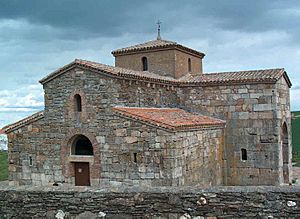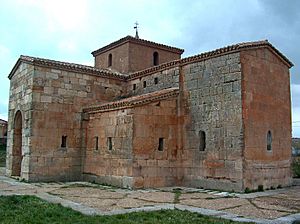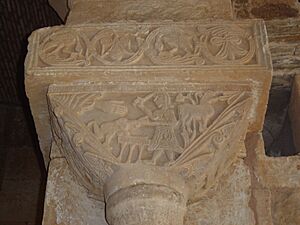San Pedro de la Nave facts for kids
San Pedro de la Nave ("St. Peter of the Nave") is a very old church in Spain. It is located in a place called El Campillo, in the province of Zamora. This church is special because it was built a long, long time ago, during the Early Middle Ages. It even had to be moved from its first location near the River Esla because a large lake was going to be created there by the Ricobayo reservoir.
This church is one of the oldest in Spain and is very important for its architecture. It is being considered to become a World Heritage Site, which means it would be recognized as a place of great importance to the world.
Contents
The church of San Pedro de la Nave was likely built between the years 680 and 711. This was during the time of King Egica, just before the Muslim conquest of Spain. This makes it one of the last buildings from the Visigothic period in Spain.
Church Design and Structure
The church first looked like a Roman cross from above. Later, two side sections were added, making it a mix between a cross shape and a long hall (like a basilica). It also has five small rooms, two on each side of the main altar area (called the presbytery). These rooms might have been used by hermits, who were people who lived alone for religious reasons.
The church has a rectangular shape, about 5.6 meters by 2.1 meters. From this main shape, eight chapels stick out. The main chapel at the end is rectangular, and there are two others at the ends of the cross-shaped part (the transept). The main central part of the church is taller and wider than the side sections. Arches supported by strong pillars separate these areas.
What the Church Looks Like Inside
The roof of the church is shaped like a half-cylinder, which is called a barrel vault. The main part of the church and the side sections still have their original stone roofs. However, the western parts of the building have brick vaults.
Special Arches and Decorations
The church uses special arches called horseshoe arches. These arches are shaped like a horseshoe, meaning they are more than a half-circle. This was a common style in Visigothic buildings. Two arches go across the main part of the church. They rest on blocks (called impost blocks) that are supported by columns attached to the walls. The arch leading to the main altar area is even more tightly curved like a horseshoe and rests on two columns.
The decorations inside the church are very beautiful and important for old Spanish art. There are two main types of decorations. First, there is a wide band of stone (a frieze) that goes around the church. It has circles with designs of plants and animals. Second, there are the tops of the columns (called capitals). These are very well made. They show stories from the Bible, like Daniel in the Lion's Den and The Sacrifice of Abraham. The top parts of these capitals are decorated with swirls that include figures of people and animals.
There is also a sundial carved into a stone on an inside wall of the church. However, this sundial was never fully finished.
Moving the Church to a New Home
The church was declared a national monument on April 22, 1912.
Originally, San Pedro de la Nave was located right next to the Esla River. But when the Ricobayo dam was built, it created a large reservoir, and the church would have been underwater. Thanks to the efforts of a person named Manuel Gómez-Moreno, it was decided that the church would be moved.
This amazing project happened between 1930 and 1932. The church was carefully taken apart, stone by stone, and then rebuilt in its current location. The architect Alejandro Ferrant Vázquez was in charge of this big move.
See also
 In Spanish: Iglesia de San Pedro de la Nave para niños
In Spanish: Iglesia de San Pedro de la Nave para niños
- List of oldest church buildings




